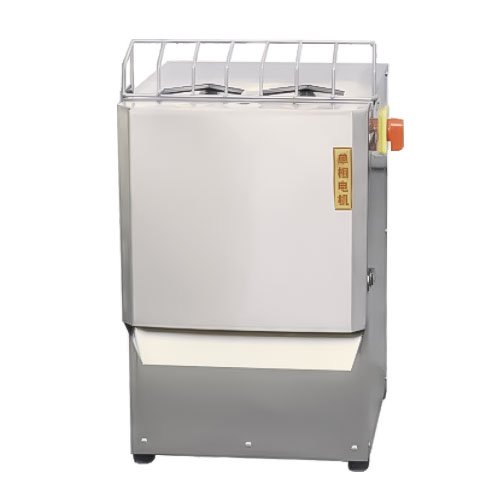
In today’s fast-paced food service industry, efficiency is everything. Whether you’re running a busy restaurant kitchen, managing a hotel dining operation, or overseeing a school cafeteria, food preparation time directly impacts your bottom line and customer satisfaction. Among the many innovations designed to streamline kitchen operations, commercial vegetable slicers and shredders stand out as game-changers for professional food preparation.
The Evolution of Vegetable Processing
Remember the days of manual vegetable cutting? Chefs and kitchen staff spending hours with knives, creating inconsistent cuts while risking injuries and dealing with significant food waste. Those challenges are becoming a thing of the past thanks to modern food processing equipment.
Today’s commercial vegetable slicers and shredders represent the culmination of years of design improvements focused on efficiency, safety, and consistency. These machines have transformed from bulky, single-purpose devices to versatile, compact workhorses that can handle multiple cutting styles with minimal setup time.
Practical Applications Across Food Service Settings
Restaurant Kitchens
In restaurant environments, presentation and consistency are paramount. A high-quality vegetable slicer ensures that every plate leaving the kitchen maintains the same professional standard:
- Creating perfectly uniform potato slices for gratins and casseroles
- Producing consistent carrot julienne for garnishes and salads
- Generating paper-thin radish rounds for elegant plating
- Preparing eggplant discs of identical thickness for even cooking
The time saved allows chefs to focus on the creative aspects of cooking rather than repetitive prep work.
Hotel Food Service
Hotels serving hundreds of guests daily benefit tremendously from efficient vegetable processing:
- Breakfast service requires large quantities of precisely cut vegetables for omelets and sides
- Buffet presentations demand visually consistent vegetable preparations
- Banquet service relies on rapid production of uniform vegetable components
With a professional vegetable processor, hotel kitchens can maintain quality while meeting demanding service schedules.
Institutional Cafeterias
School, hospital, and corporate cafeterias face unique challenges in producing large quantities of nutritious food:
- Preparing fresh vegetables for hundreds of servings daily
- Maintaining nutritional value through efficient processing
- Reducing food waste through precise cutting
- Creating appealing presentations that encourage healthy eating
Modern vegetable slicers help institutional kitchens balance nutrition, appeal, and efficiency.
The Tangible Benefits for Commercial Kitchens
Dramatic Time Savings
The most immediate benefit users experience is the remarkable time efficiency. What once took hours of manual labor can now be accomplished in minutes. A commercial-grade vegetable processor can handle hundreds of kilograms of vegetables per hour, allowing kitchens to prepare fresh ingredients just before service rather than hours in advance.
Consistency That Elevates Quality
Consistency in food preparation isn’t just about aesthetics—it directly affects cooking quality. When vegetable pieces are uniform in size and thickness:
- Cooking times become predictable
- Dishes cook evenly without some pieces burning while others remain raw
- Presentation standards remain consistent regardless of which staff member operates the equipment
- Recipe outcomes become more reliable
This consistency translates to higher customer satisfaction and fewer returned dishes.
Reduced Food Waste
Professional vegetable processors maximize yield from raw ingredients. The precision cutting mechanisms ensure that more of each vegetable becomes usable product rather than trim waste. For operations processing large volumes of vegetables, this efficiency can translate to significant cost savings over time.
Staff Allocation Flexibility
When basic prep work requires less time and fewer personnel, kitchen managers gain flexibility in staff allocation. Team members can be assigned to more complex cooking tasks or customer-facing responsibilities, improving overall operational efficiency and service quality.
Enhanced Safety Standards
Modern vegetable processing equipment incorporates numerous safety features that reduce the risk of cutting injuries common with manual food preparation. This leads to fewer workplace accidents, reduced liability, and improved staff morale.
Adapting to Diverse Menu Requirements
Today’s commercial kitchens rarely serve a single cuisine type. The versatility of modern vegetable processors supports diverse menu offerings:
- Creating thin-shredded cabbage for Asian-inspired slaws
- Producing uniform potato slices for traditional French gratins
- Generating consistent vegetable julienne for Mediterranean presentations
- Preparing perfect cucumber rounds for sushi presentations
This adaptability allows kitchens to expand their menu offerings without investing in multiple specialized tools.
Integrating Technology into Kitchen Workflows
Introducing new equipment always requires some adjustment to established workflows. However, today’s vegetable processors are designed with user-friendliness as a priority. Most models feature:
- Intuitive controls that require minimal training
- Quick-change cutting mechanisms for switching between slicing and shredding
- Easy disassembly for thorough cleaning and sanitation
- Compact footprints that fit into existing prep areas
These design considerations make adoption straightforward even in kitchens with high staff turnover.
The Return on Investment Perspective
While professional kitchen equipment represents a significant investment, vegetable processors typically deliver rapid returns through:
- Reduced labor costs for basic preparation tasks
- Decreased food waste through more efficient processing
- Extended ingredient shelf life through just-in-time processing
- Improved menu consistency that builds customer loyalty
Many kitchen managers report that their vegetable processing equipment pays for itself within months rather than years.
Sustainability Considerations
Modern food service operations increasingly focus on sustainability, and efficient vegetable processing contributes to these goals:
- Reducing food waste supports sustainability initiatives
- Energy-efficient motors consume minimal electricity
- Durable construction ensures long equipment lifespan
- Precise portion control helps manage inventory and reduce overproduction
These environmental benefits align with the growing consumer preference for responsible business practices.
Conclusion: A Cornerstone of Modern Kitchen Efficiency
In the competitive food service industry, every operational advantage matters. Commercial vegetable slicers and shredders have evolved from luxury items to essential tools that support efficiency, quality, and consistency in professional kitchens.
Whether you’re operating a small restaurant, managing a hotel kitchen, or overseeing a large institutional food service operation, the right vegetable processing equipment can transform your preparation processes and free your culinary team to focus on what matters most—creating exceptional food experiences for your customers.
By investing in quality food processing equipment today, you position your operation for greater efficiency, consistency, and success in the increasingly competitive food service landscape.

